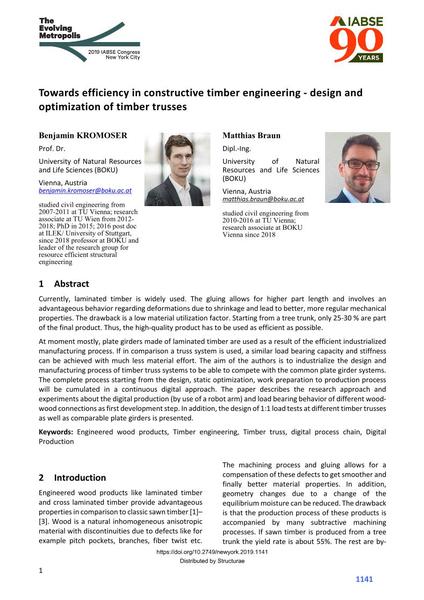Towards efficiency in constructive timber engineering - design and optimization of timber trusses

|
|
|||||||||||
Détails bibliographiques
| Auteur(s): |
Benjamin Kromoser
Matthias Braun (University of Natural Resources and Life Sciences (BOKU)) |
||||
|---|---|---|---|---|---|
| Médium: | papier de conférence | ||||
| Langue(s): | anglais | ||||
| Conférence: | IABSE Congress: The Evolving Metropolis, New York, NY, USA, 4-6 September 2019 | ||||
| Publié dans: | The Evolving Metropolis | ||||
|
|||||
| Page(s): | 1141-1148 | ||||
| Nombre total de pages (du PDF): | 8 | ||||
| DOI: | 10.2749/newyork.2019.1141 | ||||
| Abstrait: |
Currently, laminated timber is widely used. The gluing allows for higher part length and involves an advantageous behavior regarding deformations due to shrinkage and lead to better, more regular mechanical properties. The drawback is a low material utilization factor. Starting from a tree trunk, only 25-30 % are part of the final product. Thus, the high-quality product has to be used as efficient as possible. At moment mostly, plate girders made of laminated timber are used as a result of the efficient industrialized manufacturing process. If in comparison a truss system is used, a similar load bearing capacity and stiffness can be achieved with much less material effort. The aim of the authors is to industrialize the design and manufacturing process of timber truss systems to be able to compete with the common plate girder systems. The complete process starting from the design, static optimization, work preparation to production process will be cumulated in a continuous digital approach. The paper describes the research approach and experiments about the digital production (by use of a robot arm) and load bearing behavior of different wood- wood connections as first development step. In addition, the design of 1:1 load tests at different timber trusses as well as comparable plate girders is presented. |
||||
